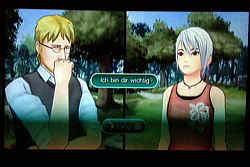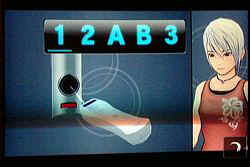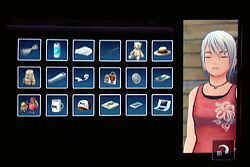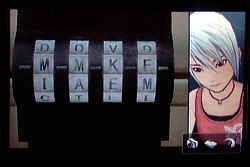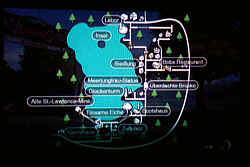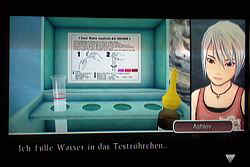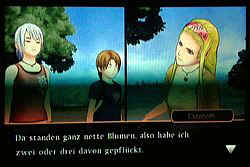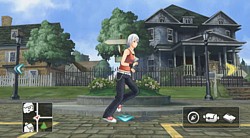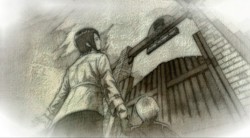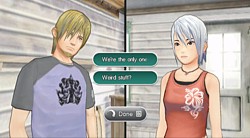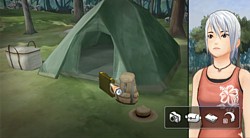Back to
Adventure-Archiv starrting page
![]() Diese Seite auf deutsch
Diese Seite auf deutsch
| Another Code R - A Journey into Lost Memories (WII)
Publisher: Nintendo Game language: German USK: 6 years and up
A review by Jehane 15th September 2009
I must admit, I was a bit hesitant when being offered to do a review on Another Code: R – mostly because I had a feeling that I was not quite fitting the group being addressed in the game and because it’s a game with a predecessor that I do not know. The first part was released for Nintendo DS only and this is a platform I’m not familiar with. Also, the game’s setting – a young girl searches for traces of her long-dead mother – didn’t really appeal to me in the beginning and I was doubting whether I’d be able to follow the story without having played the first game. Finally, I didn’t have a clue what to expect from a game that has "interactive novel" written on its cover. However, I of course couldn’t resist testing and reviewing the game for Wii.
Story Ashley Mizuki Robins, sweet 16, receives a message from her father who hasn’t been in touch for months and who, out of the blue, invites her to join him at Lake Juliet to go camping and to talk about her dead mother. As soon as Ashley arrives at Lake Juliet, her bag is being stolen by a mysterious person and her father who had promised to pick her up at the bus station is nowhere to be seen. Ashley is on her own for now and, understandably quite angry, sets out to find the camp. Soon she is being haunted by memories of her dead mother she can’t explain – when her mother was being murdered, Ashley was only three years old, hence much too young to have any clear memories at all. However, the flashbacks persist and Ashley finds out, surprisingly, that she’s been here before with her mother. But why? What was her mother’s business here and why didn’t her father know about the trip to Lake Juliet? And who’s behind the brutal murdering of Sayoko Robins? It’s up to Ashley to discover the answers and unveil the truth about her mother’s death and the project Another her mother had been working on – a project dealing with memories and manipulating them... It’s not necessary to have played the first game to follow the story; during the game, short summaries are being given but even without those it’s easy to follow the story. We learn that two years ago Ashley has received a letter from her father inviting her to Blood Edward Island. Upon arriving, he was nowhere to be seen and the main objective of the first game was to find Ashley’s father. The similarities between first and second game – a letter from Dad inviting the daughter to a mysterious place, Dad being missing when daughter arrives – are obvious and I cannot decide if they are the result of lack of creativity or deliberate. Even though Ashley and Richard seem to have found each other in the first game they still have issues – Richard, being a scientist, is too busy with his work to look after his only daughter. This conflict is a constant theme in Another Code: R and is the center around which everything else revolves. At the same time other persons spending their time at Lake Juliet have similar problems – 13-year-old Matt searches for his father who’s been missing for five years; Elizabeth, of the same age as Ashley, also has to deal with a father who’s too busy with his work and who also doesn’t want his daughter to have contact with her divorced mother. Another Code: R, therefore, revolves around complicated child-parent-relationships and will thus appeal primarily to teenagers who will know problems with parents better than adults. The game also is about coming to terms with the past, and it is about growing up. Also, you can play a little detective. The most intriguing plot-line definitely is the one concerning the power of memories and manipulating memories; this plot-line takes up more and more time and space within the game, thus pushing other subplots into the background. But don’t worry: Everything is being cleared up in the end, there are no questions left.
Characters Although the plot – which is divided into 9 chapters – is rather simple it does appeal to the player for most of the time. However, neither story nor characters are perfect. Ashley is a sweet girl, her biggest dream is to become a musician; however, she doesn’t change at all, she’s the same person at the end of the game that she was in the beginning even though she has met new people, has experienced new things and learnt stuff about her past. The other characters remain equally flat; some who, upon first meeting them, seem to be quite shady turn out to be actually quite nice persons while others who seem to be nice turn out to be villains. All cliches are being used: the bitchy girl who looks down upon everybody but is basically a lonely girl at heart; the old woman scaring everybody away from her house, hiding a soft spot behind her rough attitude; the mysterious stranger who turns out to be quite talkative; the brilliant scientist lacking emotions and emotional connections and so on. I liked the characters but I doubt that any of them will remain in my memory for a long time; all of them were too flat in the end. Also, the story couldn’t grab me for the entire time; some sequences were pretty interesting and exciting and I still think that there are some good approaches in the game. Those, however, are being ruined by predictable events, cut-off plot-lines and an overboarding dialogue system – the label "interactive novel", it seems, has been taken seriously.
Tech Stuff/Design Like all Wii-games, Another Code: R is easy to handle: insert disc, select game in main menu, play. Before you can start, the system only tests if your Wii has enough memory space left; this is repeated whenever you re-start the game. If an update is necessary, it is installed automatically within a few minutes. The design is average: The disc comes in a simple DVD-case with an extensive manual. The manual can be called ideal. Here you’ll find information on all important characters, a short summary of the story and detailled instructions on how to handle the game – and it’s all in colour! Another big plus: Loading the game doesn’t take much time; while you wait you can read a short summary of the events so far.
Handling, Inventory, and Menu Another Code: R is, at least in my opinion, the first adventure for Wii with excellent handling; there are a few exceptions I’ll talk about later. During minigames, the possibilities provided by the Wiimote are used in the best way possible and above all, handling the game is very intuitive – a quick glance at the manual is enough to get you started. Ashley can run left or right; arrows on the left or right side of the screen have to be clicked (hold down the A-button) – off Ashley goes. She changes direction automatically whenever there’s need to. Freedom of movement is, however, very limited; you can only go to places that are relevant for the story. From time to time you’ll see an arrow at the top of the screen; this indicates that you can enter a building and/or place. A magnifying glass indicates that you can investigate something more closely; most of the time, large groups of items are drawn together, outlined in yellow and shown in close-up after hitting the A-button. In close-up, you can investigate an item even closer – this is not always necessary but allows you to immerse yourself more deeply in the game’s world. The same works for dialogues – simply move the Wiimote over a character. Above the character’s head there’ll be an icon indicating that you can talk to this character. By using the A-button you can speed up conversation or interrupt them – a very useful feature I’ll talk about some more later on. Inventory can be accessed via the menu bottom right; the item you picked up last will show up on the first position in the inventory. Items in the inventory can be combined with each other or items outside the inventory resp. with other characters if necessary. Clicking on an item opens a small screen with the item in close-up and a short description of the item; you’ll also find the options "use" and "combine". Both options can be activated by using the A-button again. An annoying feature: some items can be picked up only after Ashley has realised she needs them. This results in a lot of running to and fro and is something that could have been avoided, especially since the inventory never becomes confusing. Also, you can pick up items that are of no real use, a feature I found quite vexing – Ashley will pick up an empty soda can without grumbling but when you want her to pick up, say, a rope that might be useful at some point, she refuses and needs yet another small clue before picking up the rope. This could have been solved a lot better. Bottom right you’ll also find icons for the Dual Another System (DAS) Ashley received from her father and an icon for Ashley’s digital camera in case you want to take pictures. You can take up to 20 pictures so be sure you know what to take a picture of. Via the DAS you can access the main menu; here you can read a short summary of the story so far, save the game (there are six slots for doing this), look at pictures and messages, learn interesting information about the characters and their connections. There’s an additional feature for pictures: You can take two pictures and combine them to get a new picture; you’ll need to do so in order to solve some of the puzzles. Also bottom right there’s the area map – a small map shows you where Ashley is at the moment, a larger map shows you the whole area surrounding Lake Juliet. This comes in handy when you need to find your way around; the area is pretty vast and you can get lost easily. However, it would have been nice to include a feature that allows you to jump from one place to another without having to run from point A to point B all the time.
Graphics, Sound I must admit I was quite surprised by the quality of the 2D-graphics – they might not be of the highest standard and cannot keep up with the latest games for the computer but they look good and fit the game like a glove. The characters look a bit like they would in Japanese Manga/Anime cartoons, can express emotions by using simple gestures and facial expressions. At the same time, they fit their surroundings and don’t stick out like aliens. In the beginning I had the impression that the surroundings looked like 3D-models or pictures but found out that they’re not. The surroundings are realistic enough, something is always moving – a small insect, a tiny river etc. When it comes to conversations, the talking characters are shown close-up and split-screen; they express emotions by shrugging, winking or looking a bit doubtful or even angry. This was quite a surprise especially since my first encounter with a Japanese adventure for Wii – Detective Conan – wasn’t even remotely as positive. Background noise has been kept to a minimum – there are various quite nice musical tunes to listen to, fitting the various scenes, from time to time there are additional noises, e.g. when you unlock a safe. That’s it. The dialogues have not been voiced and this is, in my opinion, the game’s biggest drawback – about 90% of the game consist in dialogue. Why there’s no voicing, I cannot understand; maybe it’s due to the fact that the Wii’s capacities are rather limited. Still, it’s very annoying and tiring when you have to read every single line of dialogue. The missing voices also hinder identification with the characters, especially during emotional situations. When dialogue lines are shown, there’s a rather annoying bubbling sound that accompanies every single word; you can avoid this by hitting the A-button so that the whole dialogue is shown instantly.
Dialogue Another Code: R is extremely heavy on conversations, probably because the game is being described as an "interactive novel". This description really nails it down – you’ll spend most of the time reading. Usually, this doesn’t bother me, quite on the contrary – I love games with lots of dialogue but only when I can actually hear what is being said and when the things that are being said actually enable me to learn more about the characters, their world, the story, the puzzles. The dialogues in Another Code: R not always provide you with that information; some conversations are extremely tiring and pointless. When I started the game, this didn’t annoy me much but the longer I played, the more annoying it got. Even with voicing, the dialogues would have been tedious at times because some of them are just pointless and don’t contribute much to the story. Most puzzles are hidden in conversations; the solutions most of the time are also hidden in conversations. If not, Ashley gives you a clue, e.g. when you click on an item twice. Speaking of which: Ashley, of course, has her standard phrases when it comes to things that are not working. However, you don’t get to hear – sorry: read these phrases very often. But you get to read simple descriptions of objects and items a lot. And I mean A LOT. If you click on a drawer, for example, Ashley will observe "A drawer". Then she’ll investigate the drawer and tell you whether she has found something or not. This procedure is repeated every single time you need to open a drawer – and there are lots of drawers in this game. If a game consists basically of dialogue, it can become very annoying and tiring having to click on standard phrases that simply are not necessary – you’ll recognize a drawer when you see one and you’ll also realise that a door is open when it opens. This procedure can get even more annoying – when it comes to using something like, let’s say, the interactive communication system to talk to other people. Instead of simply activating the system, Ashley will tell you first what it is, even if you have used the system before. This is not necessary and very irritating as you play along. Luckily, dialogues and phrases can be skipped by using the A-button. The dia- and monologues are both the greatest strength and greatest weakness of the game because they are simply overdone and provide you with information you don’t need to complete the game. Some characters indulge in smalltalk that is not important at all, at the same time pretending that what is being said is of the utmost importance. A lot of information is being repeated as well. Sometimes, new topics will pop up during conversations; however, you cannot use these topics immediately but will have to wait until the game allows you to. Sometimes, this can result in slightly illogical context; at times I would have preferred to talk about a certain topic instantly instead of having to wait until the rest of the conversation had been played out. Very rarely you’ll have the opportunity to influence the course of a conversation; in these cases, Ashley will have to decide whether she wants to tell the truth or a lie, how she wants to describe an item, etc. Two Ashleys will be shown on the screen, representing the two different statements. I cannot say whether these decisions really influenced the course of the game; my guess is that they don’t.
Puzzles Before you can start playing the game, you’ll have to pass a small test: You need to let the DAS identify Ashley’s face by moving her face to the centre of a small rectangular on screen. I thought this was an odd exercise; however, it already gave me a feel for the controls used in the game. You’ll encounter numerous puzzles and quests during the course of the game; most puzzles will be the result of a conversation, most of the time a conversation will also provide you with the solution or at least a clue. As you might have guessed, the game’s difficulty level is not very high – at best, it can be described as medium, though very rarely. Most of the time you’ll have to find new clues by talking to various people. There are also puzzles that make excellent use of the Wiimote’s possibilities – you’ll have to do a ph-test on the lake’s water and swirl the water around in a test glass, the Wiimote in this case simulating the actual movements you’d carry out when using a test glass in real life. You’ll have to lift boxes, use crank handles, wake up people, grind herbs, slide a mirror under doors and move it into the correct position so you can see what’s on the other side – in all these cases your movements are transmitted directly onto the item on screen; most of the time you’ll just have to simulate the movement you’d make in real life. Very often you’ll find yourself before closed doors but these are no obstacle, thanks to the TAS, a device developed by Ashley’s mother. Opening the doors using the TAS is not very difficult; however, this type of puzzle is overdone, especially during the final chapters – every second puzzles consists of opening a closed door. I thought this was not very clever and a bit boring. Sometimes you’ll also have to manipulate and combine items you have picked up. At the end of each chapter, there are some questions that demand answering – not really a challenge, especially since a wrong answer doesn’t result in any consequences. Even though most of the tasks are easily to perform – you get a lot of clues – the Wiimote not always plays along as it should. As I said before, the possibilities of the Wiimote have been executed very well but there are some puzzles that are just plain annoying simply because the Wiimote reacts oversensitive. For example, you’ll find a music cube that you need to open – no big deal, you also get a big fat clue as how to do it. But since the Wiimote reacts very touchy, the cube always turns in the wrong direction; you’ll need speed, dexterity and quick reaction in order to solve this puzzle. It took me about 30 trials until I finally had opened the cube simply because the Wiimote didn’t react as I wanted it to. Other tasks include codes that need to be deciphered; you have to reinstall an old set of bells. Twice you have to combine pictures taken in the DAS to find the right solution to a problem – I thought this feature was pretty intruiging even though it wasn’t used much in the game and not always when it seemed logical. For example, at one point you’ll find an old book full of pictures; quite obviously, you can do something with this book by combining pictures in the DAS. The problem is: This task isn’t necessary at all to solve the game and pops up at a point when Ashley doesn’t even know what she can do with the DAS. Speaking of the DAS: You can also use this handy device to look at pictures taken by the various security cameras; this often results in new information and/or tasks. Sometimes a random generator seems to determine how a puzzle has to be solved; this, I guess, might have been installed in order to make you replay the game. By the way: There are no dead ends and no game overs in Another Code: R – quite pleasant.
Summary Another Code: R has a lot of good moments but never reaches beyond mediocrity. This has to be blamed on the excessive use of conversations; even though the dialogues allow you to immerse yourself deeper in the game’s world, most dialogues simply are annoying and irritating. The biggest challenge, for me, was to get past those endless conversations and to ignore the repetetive, useless phrases. The tasks Ashley is confronted with should be no problem for experienced adventure gamers; even newbies shouldn’t have too hard a time solving the various puzzles. Personally, I thought it was a shame that, for most parts of the game, you, as a player, are being degraded to watching while hitting the A-button from time to time to skip some dialogue. The description as "interactive novel" has been taken quite seriously, it seems, which brings me to yet another point of criticism: The game – at least in Austria and Germany – has been approved for kids aged 6 years and up. Given the huge amount of dialogue and the sometimes scientific vocabulary, this is sheer madness – small kids won’t have the practice in reading nor the vocabulary to follow this game, hence it’s not suitable at all. The target audience are teenagers who can identify with the young heroine; adults could have some fun with the game as well if only it had been designed a little more challenging. There are good basics, the possibilities of the Wiimote are used quite well, some of the puzzles were fun. However, Another Code: R never reaches beyond mediocrity, hence the final
Rating: 60%
Adventure-Archiv rating system:
Copyright © jehane for Adventure-Archiv, 15th September 2009
Back to Adventure-Archiv starrting page
|
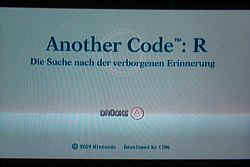 Minimalistic starting-up screen
|
|

